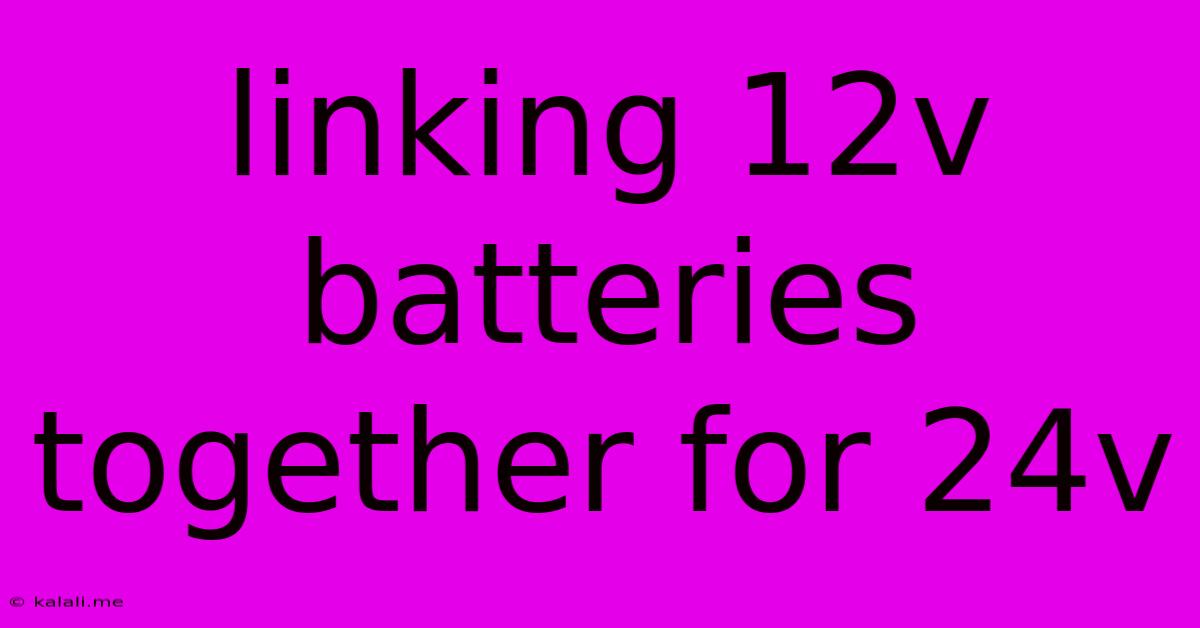Linking 12v Batteries Together For 24v
Kalali
May 23, 2025 · 3 min read

Table of Contents
Linking 12V Batteries Together for 24V: A Comprehensive Guide
Connecting two 12V batteries in series to create a 24V system is a common practice for various applications, from powering RVs and boats to supplying energy for off-grid homes and backup power systems. This guide provides a step-by-step explanation, crucial safety precautions, and considerations for successfully achieving a reliable 24V setup. Understanding the process and potential pitfalls is vital for ensuring both the safety of your equipment and yourself.
Understanding Series Connections
The key to creating a 24V system from two 12V batteries lies in understanding series wiring. In a series connection, the positive (+) terminal of one battery is connected to the negative (-) terminal of the other. The remaining positive and negative terminals become the output of your 24V system. This effectively adds the voltage of each battery, resulting in a total of 24V. Crucially, the amperage (current) remains the same as a single battery. This means the capacity of your 24V system isn't doubled; rather, the voltage is doubled.
Essential Equipment and Materials
Before you begin, ensure you have the correct tools and materials. You'll need:
- Two 12V batteries: Identical batteries are strongly recommended (same type, capacity, and age) to prevent imbalances and ensure consistent performance. Deep-cycle batteries are often preferred for applications requiring sustained power delivery.
- Battery cables: Heavy-gauge cables are essential to handle the current draw, especially for high-power applications. The gauge required will depend on the amperage requirements of your system. Consult a wiring gauge chart to ensure you choose appropriately sized cables.
- Ring terminals: These secure the connections to the battery terminals.
- Wire strippers/cutters: For preparing the battery cables.
- Crimping tool: To securely attach the ring terminals to the cables.
- Multimeter: To verify voltage and ensure proper connections.
- Safety glasses and gloves: Always prioritize safety when working with batteries.
Step-by-Step Guide to Connecting 12V Batteries in Series for 24V
-
Preparation: Ensure the batteries are fully charged before beginning the process. Inspect the battery terminals for any corrosion or damage and clean them if necessary.
-
Attach Ring Terminals: Securely crimp the ring terminals onto the ends of your battery cables using a crimping tool. Make sure the connections are robust and free from any loose wires.
-
Connect the Batteries: Connect a battery cable with a ring terminal at each end to the positive (+) terminal of the first battery and the negative (-) terminal of the second battery.
-
Complete the Circuit: Connect another battery cable with ring terminals to the negative (-) terminal of the first battery and the positive (+) terminal of the second battery. This completes the series circuit.
-
Testing: Use a multimeter to measure the voltage across the remaining positive (+) and negative (-) terminals. You should read approximately 24V. If the reading is significantly lower or higher, double-check your connections.
-
Secure Connections: Secure all connections and the cables to prevent accidental disconnections or short circuits.
Important Safety Precautions
- Always disconnect the load before working on the battery system.
- Never mix different types of batteries (e.g., lead-acid and lithium-ion).
- Ensure proper ventilation as batteries can emit flammable gases.
- Avoid short circuits. Short circuits can cause sparks, fire, or explosions.
- Wear appropriate safety gear (gloves and eye protection).
- If you are unsure about any aspect of this process, consult a qualified electrician.
Choosing the Right Batteries
The choice of battery significantly impacts the performance and lifespan of your 24V system. Consider these factors:
- Battery type: Deep-cycle batteries are ideal for applications requiring sustained power delivery.
- Battery capacity (Ah): Choose a capacity that meets your power requirements.
- Battery chemistry: Lead-acid batteries are common and relatively inexpensive, while lithium-ion batteries offer higher energy density and longer lifespans but are more expensive.
By following these steps and prioritizing safety, you can successfully create a reliable 24V system from two 12V batteries. Remember to always consult relevant safety guidelines and consider seeking professional help if you're uncertain about any aspect of the process.
Latest Posts
Latest Posts
-
Military Scifi Novel Humans Mutiny Against Aliens
May 23, 2025
-
Linux Syscall Task Struct Get Uid
May 23, 2025
-
What Does The Bible Say About Eating Pork
May 23, 2025
-
How To Get The Smell Of Gas Off Hands
May 23, 2025
-
Civ 6 Capture Barbarian Builder On Ocean
May 23, 2025
Related Post
Thank you for visiting our website which covers about Linking 12v Batteries Together For 24v . We hope the information provided has been useful to you. Feel free to contact us if you have any questions or need further assistance. See you next time and don't miss to bookmark.